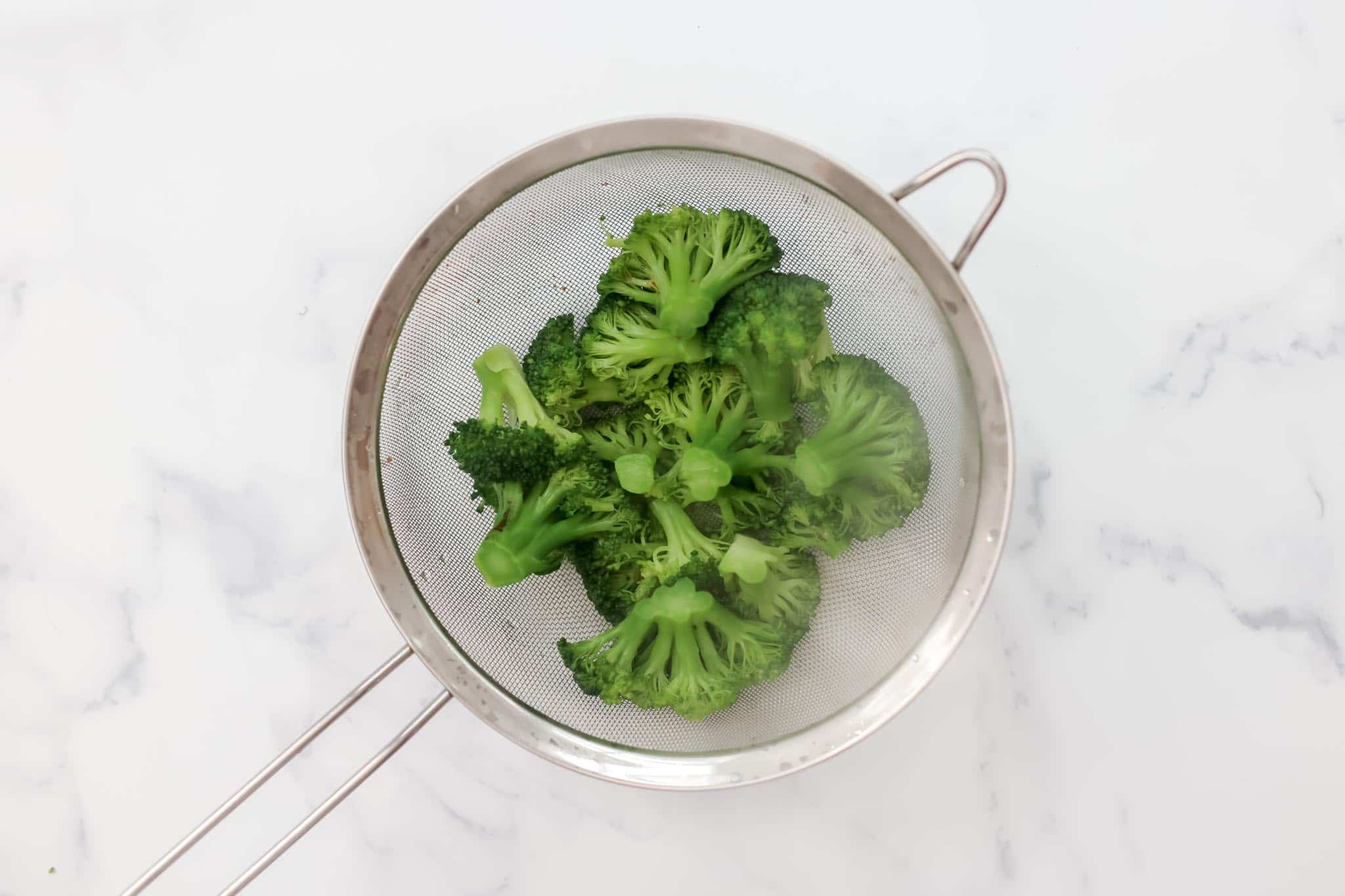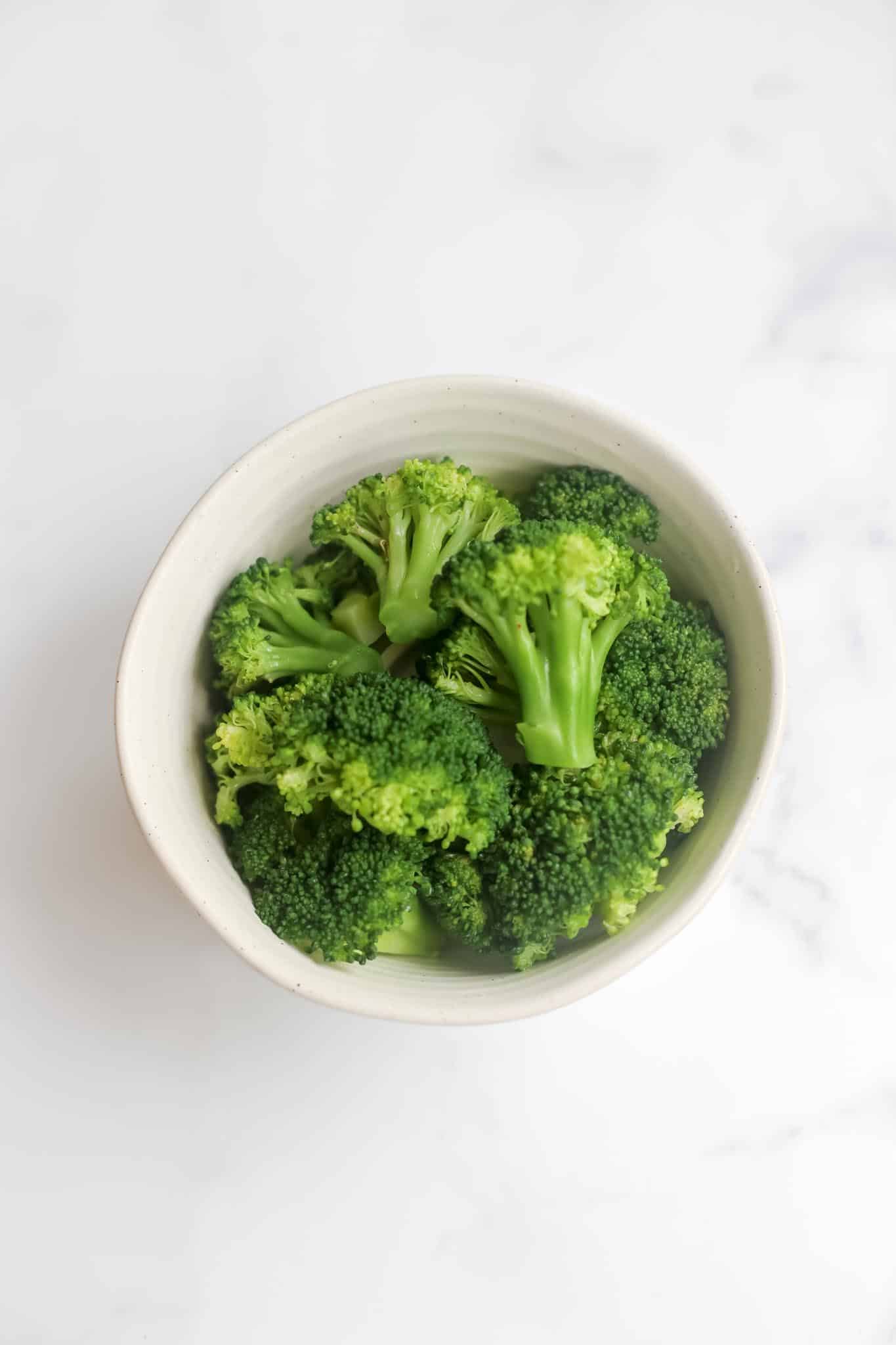Enjoy this simple boiled broccoli as a nutritious side dish or an ingredient to add to other recipes. Ready in 5 minutes.

Broccoli is a nutritious green vegetable that is an excellent addition to a healthy diet. It can be incorporated into many recipes as an ingredient and is used in various cuisines. Broccoli is also delicious by itself as a side dish with minimal seasonings or additions.
Broccoli belongs to the cruciferous family of vegetables, which also includes cauliflower, brussels sprouts, and cabbage. It is also known for its nutrient density and health benefits.
Broccoli is straightforward to prepare and tastes best when cooked quickly, so that it retains a crisp texture, vibrant green color, and all those valuable nutrients.
Benefits of Broccoli
Broccoli is full of vitamins, minerals, and fiber to help keep you feeling full and at your best. It is also low in calories, making it a popular choice among health-conscious people and gym-goers. Broccoli is also an excellent choice as a baby's first food as they begin to eat solid foods - just make sure it is cooked appropriately.
Broccoli is very simple to prepare and can be cooked in several ways with little effort.
How to Cook Broccoli
Broccoli is a versatile vegetable that can be prepared in several different ways, each with a slightly different texture and flavor. Read on for a detailed step-by-step guide on how to boil broccoli.
If you are curious about other ways to prepare broccoli, here is an overview of some other popular methods:
- Boiling - involves submerging florets in boiling water until crisp-tender. It's a simple method that retains the vegetable's color and nutrients. Read on for a quick step-by-step process of how long to boil broccoli.
- Roasting - enhances the natural sweetness of broccoli and creates a crispy texture with caramelized or charred edges.
- Steaming - similar to boiling, steaming broccoli preserves its nutrients and vibrant green color while maintaining a crisp texture.
- Stir-Frying - quickly cooks broccoli at high heat in a wok with oil, retaining its crunch and vibrant color while incorporating a flavor-packed stir-fry sauce.
- Raw - when grated, thinly sliced, or finely chopped, broccoli adds a refreshing crunch to salads and coleslaws. It should be in small pieces, as the texture will be tough.
- Grilling - imparts a smoky flavor and enhances its natural sweetness.
- Blanching - involves briefly boiling broccoli, followed by an ice bath to stop cooking, preserving its color and nutrients.

What you'll need to make boiled broccoli
Here are the ingredients you'll need for perfect boiled broccoli every time:
Broccoli: The star of the show, a head of broccoli will be sliced into florets and boiled to create a healthy and delicious side dish.
Water: Our cooking method! Simply fill a pot with tap water and bring it to a rolling boil.
Salt: An optional seasoning that can be added to the water during boiling to infuse the broccoli with a light seasoning and enhance the overall flavor.
Equipment
Here's the essential kitchen equipment you will need to boil broccoli:
Pot or Saucepan: A large pot or saucepan to accommodate the broccoli comfortably without overcrowding during boiling.
Colander: For draining the boiled broccoli after cooking.
Sharp Knife: To trim and cut the broccoli into florets.
Chopping Board: A surface for slicing the broccoli (to protect your countertop).
Slotted Spoon or Tongs (optional): Helpful for removing broccoli from boiling water instead of pouring through a colander, but not essential.
Step-by-Step Instructions: How Long to Boil Broccoli
Boiling broccoli is a straightforward method that only takes a few minutes and retains its vibrant color, crunch, and essential nutrients. Here's a step-by-step guide to getting perfect boiled broccoli every time.
Step One: Prepare
Wash the broccoli thoroughly under cold running water. Trim off the dry end of the stem and remove any leaves or damaged parts.

Cut the broccoli into bite-sized pieces of even size for uniform cooking.

The stem is edible, so if you want to eat it, slice it into small bite-size pieces.

Step Two: Boil Water
Fill a large pot of water. Use a pot that accommodates the broccoli without overcrowding.
Bring the water to a rolling boil over high heat. Add a generous pinch of salt to season the broccoli evenly while cooking.

Step Three: Cook Broccoli
Submerge the broccoli florets entirely in the boiling water and cook for 3-4 minutes, depending on the desired tenderness. Pierce with a fork to test if the broccoli is done; it should be tender yet firm.
Step Four: Drain & Serve
Once cooked to the desired tenderness, promptly drain the broccoli using a colander.

Serve immediately while hot. If preparing in advance, you can pat dry and store it in an airtight container in the refrigerator for up to three days.

Boiling vs. Blanching Broccoli
You may have heard of the term 'blanching' broccoli or other vegetables. Blanching is a method that is very similar to boiling but with some minor differences. During blanching, the cooking time is slightly shorter (about 1 minute less than boiling). The vegetable is placed into a bowl of ice water immediately after boiling to stop the cooking process to retain a crisp texture and vibrant color.
Blanching will be an excellent alternative if you plan to cook the broccoli in advance (like during meal prep). Here is a brief guide to the benefits and when to use each method:
Boiling:
- Softer texture.
- It is ideal for recipes with broccoli as a central component, such as soups or casseroles.
- It requires marginally longer cooking time, less precision, and fewer steps.
Blanching:
- Preserves firmer crisp-tender texture and vibrant color.
- It yields a crisper texture, suitable for broccoli salads or as a side dish.
- It has a slightly shorter cooking time but requires the additional step of an ice bath (a bowl of chilled water with ice).
Storage Tips
After boiling, cool the broccoli before storing. For refrigeration, use an airtight container for up to 3 days. For freezing, cool, then freeze in a single layer on a baking sheet. Transfer to a freezer-safe bag or container, removing excess air. Frozen boiled broccoli maintains quality for up to 6 months.

How to Reheat Boiled Broccoli:
Microwave: Place boiled broccoli in a microwave-safe dish. Cover loosely to retain moisture and save you from cleaning the microwave. Reheat in short intervals, stirring occasionally, until warmed through.
Stovetop:
- Use a saucepan or skillet over medium heat.
- Add a small amount of oil or water to prevent sticking.
- Stir the boiled broccoli continuously until it reaches the desired temperature.
Steamer Basket:
- Place the broccoli in a steamer basket over boiling water. Cover and steam until heated thoroughly.
Serving Suggestions
Broccoli's versatility makes it a great side or ingredient for many dishes and cuisines. Here are some pairing suggestions:
- Grilled Chicken: A typical post-gym meal! Serve boiled or roasted broccoli alongside grilled chicken breasts or thighs for a balanced and nutritious meal.
- Pasta Dishes: Add blanched broccoli florets to pasta dishes like penne or spaghetti, complementing the flavors with olive oil and garlic.
- Stir-Fries: Incorporate broccoli into stir-fries with tofu, shrimp, and other colorful vegetables with a soy sauce based stir-fry sauce for seasoning.
- Salads: Include florets in broccoli salad or coleslaw for a refreshing crunch.
- Burrito Bowls: Combine steamed broccoli with brown rice, shrimp, and a savory sauce for a fulfilling and wholesome burrito bowl.
- Roasted Vegetables: Roast broccoli alongside carrots, cauliflower, and bell peppers to create a colorful side of mixed vegetables.
- Lemon: Plain broccoli with a simple squeeze of fresh lemon or balsamic vinegar, salt, and cracked pepper is a simple but fresh side dish. You can add a pat of butter if you want a creamier taste.
- Cheese: Broccoli and cheese is an old standard! We prefer shredded sharp cheddar, but some people like Cheez Whiz, melted Velveeta, Parmesan, or another type of shredded cheese.
FAQ
How long should you boil broccoli?
Boiling broccoli usually takes 3-4 minutes to become tender yet still crisp and fresh. However, cooking times may vary based on the desired texture and the size of the florets. Test if your broccoli is cooked by piercing it with a fork - it should be firm yet tender.
What is the best cooking method for broccoli?
The best cooking method for broccoli depends on personal preference and the intended dish. Boiling, steaming, roasting, and blanching are standard methods; each has a slightly different final texture and flavor.
Is it better to boil or steam broccoli?
Both boiling and steaming are suitable methods for cooking broccoli. Steaming tends to have a crisper final texture rather than boiling.
How do you boil broccoli without it going soggy?
Simple - don't overcook it! Only add fresh broccoli to boiling water (not cold) and monitor the boiling time closely; 3-4 minutes is plenty. Remove immediately from the heat and drain.
Do you add broccoli before or after the water boils?
Boiling water first helps cook the broccoli more evenly and prevents it from becoming soggy and overcooked.
Recipe
This article originally appeared on Pink When.










Comments
No Comments